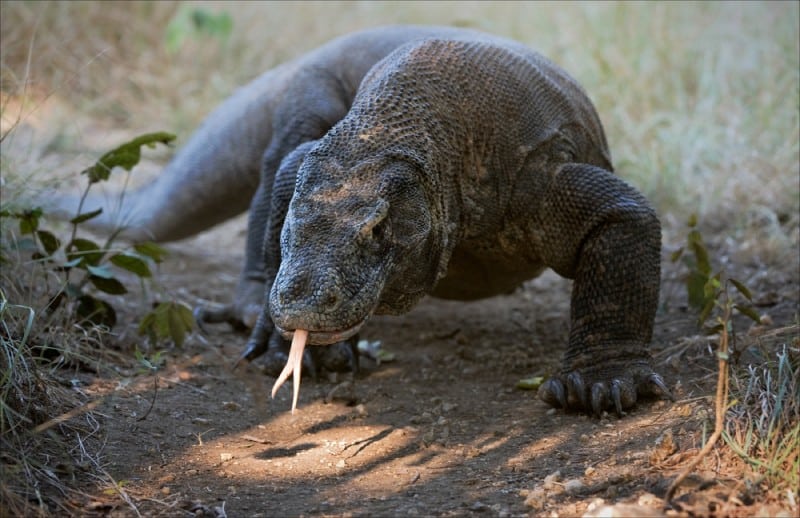
Komodo Dragon Facts
- Most notably, the astounding Komodo Dragon remains the largest known living species of lizard on earth. This fact comes as no great surprise, however. That holds true because it is a member of the Family of monitor lizard.
- Due to the remoteness of its habitat range, it remained unknown to western researchers until 1910. Following that discovery, it quickly became apparent that it constituted an apex predator in its environment.
- In fact, the amazing reptile demonstrates enormous power, especially with its long tail. On several occasions, researchers have witnessed it knocking down grown deer with a swipe of the tail, often breaking their legs in the process.
- Despite its great size and power, however, it faces many threats to its continued existence. Climate change and habitat loss serve as the two greatest dangers it faces. Due to its precarious situation, the IUCN currently lists it as Endangered.
Related Articles
Komodo Dragon Physical Description
First of all, the sheer size of the awesome Komodo Dragon serves as its most distinguishing feature. Yet, sexual dimorphism does create slight variations if physical size. But in its case, these physical differences are less than in some related species.
Firstly, some individuals grow to a maximum length of 10 ft (3 m) and weigh as much as 200 lbs (91 kg). Secondly, however, an average adult male weighs roughly 150 lbs (68.2 kg) and measures 8.5 ft (2.6 m) in length. But thirdly, an average female weighs 143 lbs (65 kg), and measures 7.5 ft (2.3 m) in length.
Furthermore, the creature remains a rather a unique animal, for several reasons. It has a tail as long as its body, as well as about 60 frequently replaced, serrated teeth that can measure up to 1 in (2.5 cm) in length. It also possesses a long, yellow, deeply forked tongue.
Additionally, the saliva of the creature frequently tends to be blood-tinged. This occurs because its teeth are almost completely covered by gingival tissue that becomes naturally lacerated during the feeding process.
- Kingdom: Animalia
- Phylum: Chordata
- Class: Reptilia
- Order: Squamata
- Family: Varanidae
- Genus: Varanus
- Species: V. komodoensis
Komodo Dragon Distribution, Habitat, and Ecology
The phenomenal Komodo Dragon inhabits an extremely limited habitat range. That’s due to the fact that it only lives natively on the Indonesian islands of Komodo, Rinca, Flores, Gili Motang, and Padar, in Asia.
In addition, even there it has certain preferences for the types of area it lives in. The powerful reptile prefers hot and dry places and typically lives in dry, open grassland, savanna, and tropical forest at low elevations.
Additionally, as an ectotherm, it remains most active in the day, although it does exhibit some occasional nocturnal activity. Komodo Dragons also evolved as solitary, usually coming together only to breed and eat.
The Komodo Dragon is a powerful carnivore. Although it eats mostly carrion, individuals will also ambush live prey with a stealthy approach. When suitable prey arrives near a dragon’s ambush site, it will suddenly charge at the animal and go for the underside or the throat.
Komodo Dragon Offensive and Defensive Adaptations
Despite all its other fascinating traits, the incredible Komodo Dragon fascinates researchers for still more reasons. It also further distinguishes itself as one of the most amazing reptiles on the earth, because of it several remarkable evolutionary adaptations for its defense.
For one, the fascinating animal evolved extraordinarily tough skin that has a naturally occurring reinforcement of armored scales. This natural armor contains tiny bones called osteoderms that function as a sort of natural chain-mail.
In another distinctive adaptation, the technically non-venomous Komodo Dragon actually possesses a toxic bite. In an amazing twist of natural processes, this occurs due to the extreme amount of bacteria present in its saliva.
Further the reptile remains able to locate its prey using its extraordinarily keen sense of smell. In fact, due to this keen sense, the massively powerful animal can actually locate a dead or dying animal from a range of up to 6 miles (9.5 km).
Finally, it evolved the ability to consume prodigious quantities of food in a single feeding, as many snakes do. As a result, these large lizards often consume as much as 80% of their pre-meal body weight in one feeding.
Species Sharing Its Range
Check out our other articles on 5 Spellbinding Scorpions, Long Eared Owl, Bora Bora, Scottish Wildcat, Peach Palm, Asian Giant Hornet, Spotted Handfish, Purple Frog, Gila Monster
